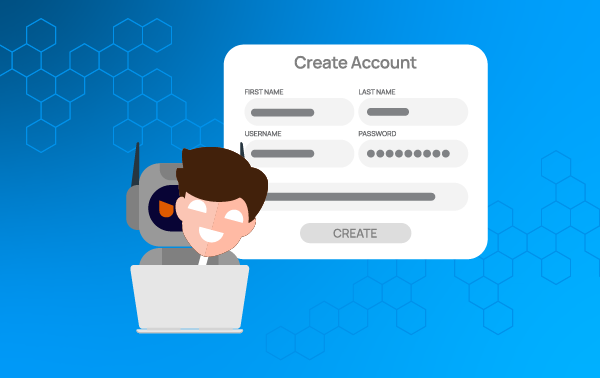What is Fake Account Creation? How to Detect and Prevent It

TL;DR:
- Fake accounts creation uses bots to mass-generate profiles with stolen or synthetic identities.
- Fraudsters exploit these fake accounts for ad fraud, free trial abuse, and disinformation.
- Businesses lose money, trust, and accurate analytics to fake account activity.
- Legacy tools like CAPTCHA and MFA slow users, but don’t stop modern bots.
- Real-time solutions like Anura detect and block fake account creation with 99.999% accuracy.
What is Fake Account Creation?
Fake account creation is when fraudsters or automated systems register new user accounts using false, stolen, or AI-generated information. These fake profiles may look legit, complete with profile pictures, bios, and realistic behavior, but they’re designed to exploit platforms for personal or financial gain.
Modern fraudsters often use synthetic identities, combining real and fake data to bypass traditional verification systems. These accounts can sit dormant for months before being activated for spam, ad fraud, or larger coordinated attacks.

How Cybercriminals Create Fake Accounts
Fraudsters rely on automation tools and AI-powered bots that can simulate human activity like typing, scrolling, or clicking to outsmart traditional defenses.
- Use stolen data from breaches to generate “realistic” identities
- Employ bot farms or click farms to scale account creation
- Leverage AI to produce convincing headshots and bios
- Rotate IP addresses and device fingerprints to avoid detection
This sophistication makes fake account detection harder than ever.
How Fake Accounts are Used in Fraud
Once fake accounts are created, they’re weaponized for profit or disruption. Common examples include:
- Account takeovers: Using fake accounts to gain access to legitimate user accounts. These accounts send password reset requests or friend/connection requests as part of sophisticated social engineering schemes.
- Ad Fraud: Bots mimic legitimate users to inflate impressions and clicks, draining marketing budgets.
- Credential stuffing: Testing stolen username/password combinations at scale. Criminals use networks of fake accounts to systematically attempt logins across multiple platforms, exploiting password reuse.
- Free Trial Abuse: Fake users repeatedly access limited-time offers without paying.
- Influence Operations: Fraudsters manipulate engagement metrics or spread misinformation through poor reviews or negative comments.
- Referral and Reward Exploitation: Fraudsters game loyalty programs using fake profiles.
Even small-scale operations can damage analytics, leading marketers to chase false performance signals.
The Business Impact
Fake accounts don’t just waste ad spend, they erode trust.
- Analytics become unreliable, leading to poor campaign decisions.
- Customer acquisition costs increase as conversion rates decline.
- Security risks arise when fake users flood sign-up systems.
According to recent industry reports, fake account activity can inflate engagement metrics by 30% or more, creating a ripple effect across marketing, sales, and finance teams.
Modern Prevention: From Detection to Continuous Authentication
Traditional defenses like CAPTCHA, Multi-factor authentication, and IP blocking slow down legitimate users but fail to stop AI-powered fraud.
Modern fraud prevention needs a different approach, one that stops fraud at the source, preventing it from ever skewing campaign metrics. Solutions like Anura operate seamlessly in the background, blocking fake activity in real time without disrupting user experience.
How Anura Stops Fake Account Creation
Anura detects fake account creation attempts by analyzing hundreds of data points in real time. Unlike basic filters or post-event audits, Anura prevents fraud at the source, ensuring only genuine users engage with your site.
This means:
- No wasted spend on invalid traffic.
- No false positives blocking real users.
- More accurate analytics and higher campaign ROI.
With 99.999% accuracy when marking a visitor as fraudulent with Anura Script, Anura protects your brand reputation and bottom line without disrupting the user experience.
FAQs
Are fake accounts created manually or by bots?
Both. Many are automated through bot networks that can create thousands of fake profiles in seconds, but fraud farms also employ real people to mimic legitimate human behavior and avoid basic detection systems.
Do CAPTCHAs stop fake account creation?
Not effectively. While CAPTCHAs block basic bots, sophisticated fraud tools and human fraud farms can bypass them. Overuse of CAPTCHAs also frustrates legitimate users and increases abandonment rates.
What industries are most affected by fake account creation?
Any business with online registrations is at risk, but it’s especially prevalent in eCommerce, SaaS, social media, streaming, and fintech, where accounts hold monetary or reputational value.
Is fake account creation illegal?
Yes. Fake account creation violates most platforms’ terms of service and can breach anti-fraud, identity theft, and computer misuse laws, especially when linked to monetary or data theft.
What’s the difference between fake account creation and account takeover?
Fake account creation involves creating new, fraudulent accounts, while account takeover occurs when a criminal gains unauthorized access to a legitimate user’s existing account. Both harm trust and business performance but require different defenses.

